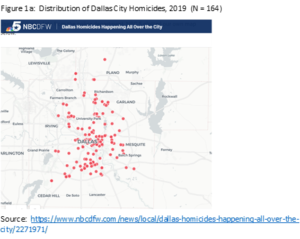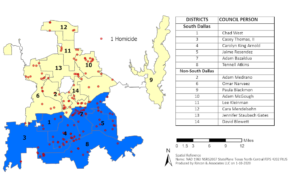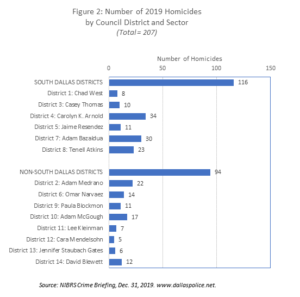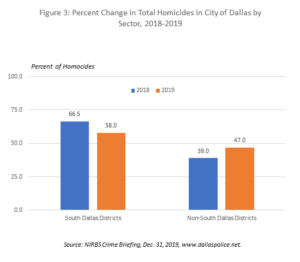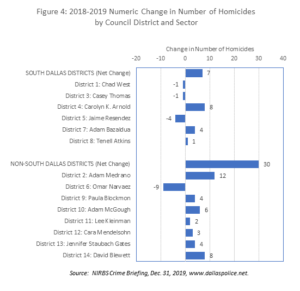A recent headline in The Dallas Morning News sent its readers a chilling message: “Dallas has had 200 murders in 2019. Here’s what that means.” [i] It reminded everyone of the unfortunate consequences of urban growth and the absence of sensible gun control. With 40 homicides recorded for the month of May according to news reports,[ii] Chief of Police Hall requested that Gov. Gregg Abbott send state troopers to assist the under-staffed Dallas Police Department to help control the alarming rise in homicides.[iii]
Although few specifics were provided on the type of support that the state troopers provided,[iv] news reports indicated that it was focused on the South Dallas community, that community residents felt that the troopers presence did more harm than good and created a sense of distrust.[v] This sense of distrust of DPS troopers was underscored by the slaying of a black resident in South Dallas who was stopped for failing to signal a turn.[vi] Although conflicting reports emerged about whether the victim had drawn a gun or not, the Texas Department of Public Safety declined to release video footage of the incident, and the two state troopers were not indicted for the incident. The victim had been shot 16 times by the state troopers – five times in the front and four times in the back of his torso according to the autopsy report.
This is not the first time that South Dallas has been singled out in reports related to increased crime. Interestingly, the Dallas Morning News story further explained that the “majority of homicides occurred in South Dallas zip codes” but did not provide its readers any detailed crime statistics to support this conclusion.[vii]
Adding fuel to the fire was a recent study of South Dallas published in Urban Science [viii]by two social scientists who concluded that “South Dallas is safer than only 13% of the cities in Texas and there is a 1 in 17 chance of becoming a victim of any crime.”
In providing such a disparaging picture of South Dallas, one would hope that journalists and social scientists are doing their due diligence in analyzing crime data. Unfortunately, that is not always the case.
Indeed, other independent analyses provide a different picture of crime in South Dallas. For example, D Magazine[ix][x] and NBC 5[xi] recently released news stories that addressed the pattern of homicides by including a map of City of Dallas 2019 homicides produced by Robert Mundinger (www.themap.net). According to these stories, homicides were “pretty much everywhere.” Figure 1a below displays the map of homicides included in the NBC 5 story which illustrates the wide dispersion of homicides throughout the City of Dallas, which is similar to the map included in the D Magazine stories on the same topic. While the map provides a general illustration of the distribution of homicides, it lacks important information about the boundaries that define which city council districts are included in the South Dallas and non-South Dallas sectors.
I produced the map below (Figure 1b) which presents the current city council district boundaries and council person names to better illustrate the geographic distribution of homicides, especially when drawing conclusions about the concentration of such crimes between South Dallas and non-South Dallas districts.
Figure 1b: Distribution of Homicides by Dallas City Council Districts (N = 161)
Neither of these two maps, however, display all of the homicides for 2019 since complete information was available only for 164 cases in Figure 1a and 161 cases in Figure 1b when these maps were produced. These missing cases, of course, could change the overall pattern of homicides displayed by these two maps.
In addition to the lack of geographic precision in previous news reports, I decided to verify the 2016 crime rates in South Dallas reported in Urban Science by the two social scientists. My statistical analysis of 2016 violent and property crime rates using Dallas Police Department data revealed that the South Dallas crime rates reported in the Urban Science article were highly inflated and not supported by the sources that were cited in the published study. My analysis also confirmed that violent and property crimes were distributed throughout the City of Dallas and not overly concentrated in South Dallas.[xii]
Why the contradictory picture of homicides in South Dallas? The contradictory picture of homicides may result from several factors. First, it is likely that the rush to report changes in homicide rates that reinforce pre-existing perceptions of crime in South Dallas may be one factor that precludes a more careful analysis of crime patterns. Secondly, South Dallas is composed of several council districts whose crime patterns can vary considerably. Thirdly, Dallas County – whose population consists mainly of the City of Dallas — is among the top ten fastest growing counties in the U.S.[xiii], suggesting that an increase in the number of homicides could be a consequence of population growth as well.
The consequences of inconsistent crime reporting are problematic for several reasons. It is well known, for example, that the perception of high crime rates in urban communities has been a key factor in slowing their economic development.[xiv] While some neighborhoods in urban communities may indeed show high crime rates, is it fair to stigmatize an entire community based on crime incidences in smaller neighborhoods? Moreover, is it fair to stigmatize a community based on inaccurate or inflated crime rates? Perhaps a closer look at crime patterns in the City of Dallas may help us to re-think what we currently know about crime rates in South Dallas.
A closer look at the pattern of homicides in the City of Dallas challenges conventional thinking about crime. A more complete picture of 2019 homicides was obtained by accessing the Dallas Police Department’s NIBRS reports of crime activity dated as of 12-31-19.[xv] Figure 2 below presents the distribution of the 207 homicides by council districts located in the South Dallas and non-South Dallas sectors of the city. From this chart, it is clear that a slight majority (56.0%) of the homicides occurred in the South Dallas districts, while less than half (44.0%) of the homicides occurred in the non-South Dallas districts.
Interestingly, the number of homicides varied greatly within the two sectors. For example, a higher number of homicides occurred in District 4 (n=34), District 7 (n=30), District 8 (n=23), District 2 (n-22), and District 10 (n=17). In addition, several of the districts in the South Dallas sector revealed a relatively low number of homicides (District 1 (n=8), District 5 (n=11), and District 3 (n=10) when compared to some districts in the non-South Dallas sector. Thus, individual districts in the non-South Dallas sector are also contributing to the overall number of 2019 homicides. However, what are the relative changes in the overall share of homicides since 2018 for the South Dallas and non-South Dallas sectors? This answer to this question is addressed by Figure 3 below.
Figure 3 compared the change in the percent of total homicides between 2018 and 2019. It is evident that the share of homicides in South Dallas districts declined from 66.5 percent in 2018 to 58.0 percent in 2019, while the share of homicides in non-South Dallas districts increased from 39.0 percent in 2018 to 47.0 percent in 2019. Thus, council districts in the South Dallas sector appear to be making progress in reducing their share of total homicides in 2019, while an increasing share of 2019 homicides has shifted to districts in the non-South Dallas sector – an important trend that should not be overlooked in future interventions by state and city leaders.
Figure 4 below examines changes in the number of homicides from 2018 to 2019 for each council district. First, the net change in homicides was considerably less (n=7) for the South Dallas districts when compared to the non-South Dallas districts (n=30). It is particularly noteworthy that during this one-year period, three of the South Dallas districts showed decreases in the number of homicides, while most non-South Dallas districts showed increases in the number of homicides. Indeed, only one non-South Dallas district (District 6) showed a decrease in the number of homicides. Based on this analysis, it seems that the recent deployment of state troopers was misguided by the singular focus on the South Dallas community.
Lastly, I was curious about the geographic distribution of the 40 homicides that were previously reported for May of 2019 and used as justification by City leaders to invite DPS trooper support from Gov. Gregg Abbott. In searching the same sources of police incidents used in this report, only 25 homicides were confirmed for May of 2019. Table 1 below summarizes the geographic distribution of these 25 homicides.
Table 1: Distribution of Homicides for May 2019
|
District
|
No. Homicides
|
|
South Dallas
|
|
|
District 1
|
1
|
|
District 4
|
6
|
|
District 7
|
5
|
|
District 8
|
1
|
|
Subtotal
|
13
|
|
Non-South Dallas
|
|
|
District 6
|
3
|
|
District 9
|
3
|
|
District 10
|
1
|
|
District 11
|
2
|
|
District 12
|
2
|
|
District 14
|
1
|
|
Subtotal
|
12
|
As is readily apparent from Table 1, the number of homicides in the South Dallas and non-South Dallas sectors were nearly identical. Consequently, one is left to wonder why the state troopers focused their intervention primarily on South Dallas.
Conclusion: In summary, it seems that some improvement is needed in the manner that crime is analyzed as well as decisions that are based on these analyses. In the case of social scientists, there is really no excuse for inflating crime statistics using unreliable sources. Crime reports that lack geographic detail are likely to lead to misguided interventions, such as the state troopers that were sent to the South Dallas community that perhaps should have been directed to other non-South Dallas council districts that were experiencing relatively more increases in the number of homicides since 2018.
It might also be a good idea to recognize districts that show yearly progress in reducing the number of homicides or at least not showing any increases in the number of homicides. Both journalists and social scientists need to exercise greater care in reporting crime trends in general, but particularly for communities like South Dallas whose quality of life has been negatively impacted by incomplete or inaccurate crime reports. Indeed, the sources of crime data used in this report are publicly available and not overly complex to analyze.
The recent announcement by Chief Hall[xvi] about initiating a “predictive policing” plan offers some promise for reducing crime by creating an intelligence-led policing unit that will “produce regular reports to forecast trends, identify patterns, and facilitate a more accurate picture of who is committing a crime and where….it will also generate a list of known offenders, active gang members, parolees, and sex offenders for each focus area.” Some activists and community members, however, expressed skepticism and felt that the new plan will lead to racial profiling and more aggressive police tactics towards the victims of crime.
The predictive police plan, coupled with a more careful analysis of the geographic distribution of crime patterns, should help to direct interventions to the communities that show the greatest need – not just the usual suspects.
Reference Notes
[i]Garcia, N. (2019, Dec. 20). Dallas has 200 murders in 2019. Here’s what that means. The Dallas Morning News. Accessed at https://www.dallasnews.com/news/crime/2019/12/20/dallas-has-had-200-murders-in-2019-heres-what-that-means/
[ii] Jaramillo, C. (2019, June 7). Texas Gov. Gregg Abbott announces he’s sending state troopers to Dallas to tackle violent crime. Dallas Morning News. Accessed at https://www.dallasnews.com/news/2019/06/08/texas-gov-greg-abbott-announces-he-s-sending-state-troopers-to-dallas-to-help-tackle-violent-crime/
[iii]Byrne, E. (2019, June 7). Gov. Gregg Abbott deploys DPS to combat Dallas violent crime spike. The Texas Tribune. Access at https://www.texastribune.org/2019/06/07/Texas-governor-Greg-Abbott-DPS-Dallas-crime/
[iv]Jaramillo, C. (2019, June 7). Texas Gov. Gregg Abbott announces he’s sending state troopers to Dallas to help tackle violet crime. The Dallas Morning News, Accessed at https://www.dallasnews.com/news/2019/06/08/texas-gov-greg-abbott-announces-he-s-sending-state-troopers-to-dallas-to-help-tackle-violent-crime/
[v]Perez, G. (2019, August 5). Are state troopers in South Dallas doing more harm than good? Texas Standard, Accessed at https://www.texasstandard.org/stories/are-state-troopers-in-south-dallas-doing-more-harm-than-good/
[vi]Jaramilllo, C. (2020, January 3). South Dallas man slain by DPS troopers after traffic stop had 16 gunshot wounds, autopsy shows. The Dallas Morning News. Accessed at https://www.dallasnews.com/news/crime/2020/01/04/south-dallas-man-slain-by-dps-troopers-after-traffic-stop-had-16-gunshot-wounds-autopsy-shows/
[vii]Ibid, Garcia N. (2019).
[viii]Crowe, J., Lacy, C., and Columbus, Y. (2019). Barriers to food security and community stress in an urban food desert. Urban Science. Accessed at https://www.mdpi.com/2413-8851/2/2/46
[ix]Wise, K. (2019, December 13). Dallas homicides are pretty much everywhere. D Magazine. Accessed at https://www.dmagazine.com/frontburner/2019/12/dallas-homicides-are-pretty-much-everywhere/
[x]Shinneman, S. (2019, December 18). Explore this updated map of Dallas’ 2019 homicides. D Magazine, December. Accessed at https://www.dmagazine.com/frontburner/2019/12/explore-this-updated-map-of-dallas-2019-homicides/
[xi]Kathoff, K. Dallas homicides happening all over the city. NBC 5 Dallas-Ft. Worth. Accessed at https://www.nbcdfw.com/news/local/dallas-homicides-happening-all-over-the-city/2271971/
[xii] Rincon, E.T. and Tiwari, C. (2019). Construction of a Demand Metric for Supermarket Site Selection: A Case Study of South Dallas. Presentation at Applied Geography Conference, Charlotte NC, October 24, 2019
[xiii]Census Bureau, New Census Bureau estimates show counties in South and West lead nation in population growth. Release No. CB 19-55, Table 3 Top 10 Counties in Percentage Growth: 2017-2018. Accessed at https://www.census.gov/newsroom/press-releases/2019/estimates-county-metro.html
[xv]City Council Briefing, NIBRS Crime Briefing, Reported through Tuesday, December 31, 2019. Accessed at http://www.dallaspolice.net/resources/CrimeReports/NIBRS%20Weekly%20Admin%20Council%20Report%20New.pdf
[xvi]Jaramillo, C. (2020, January 3). ‘Predictive policing,’ part of Chief Hall’s crime plan, raises concerns. The Dallas Morning News. Accessed at https://www.dallasnews.com/news/crime/2020/01/04/predictive-policing-part-of-chief-halls-crime-plan-raises-concerns/



